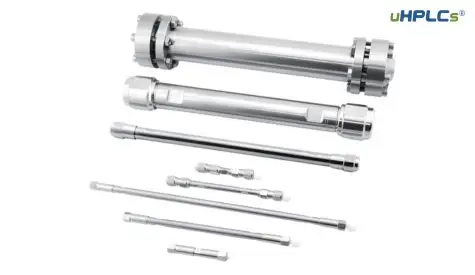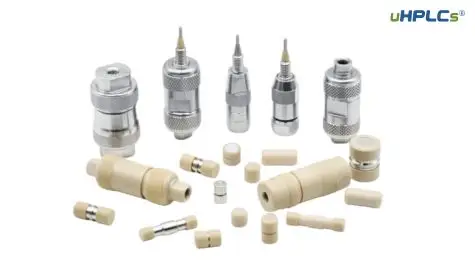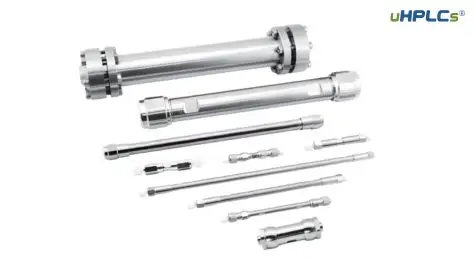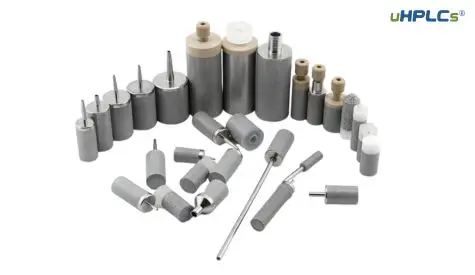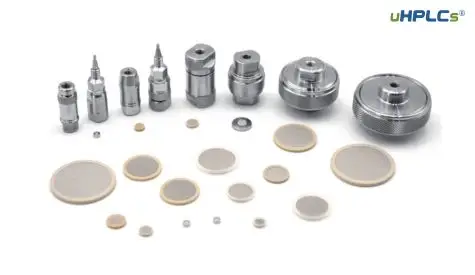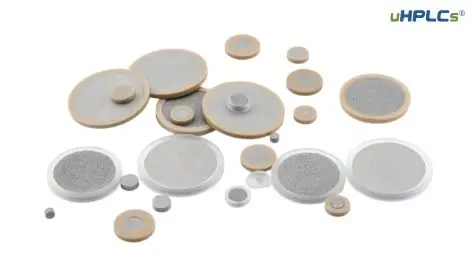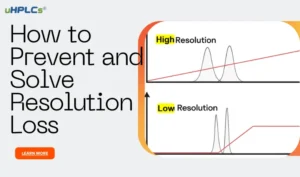1. Introduction to HPLC Column Size
High-Performance Liquid Chromatography (HPLC) is a cornerstone of modern analysis across pharmaceuticals, biotechnology, food safety, and environmental testing. At the heart of every separation is the HPLC column, and its size—length, internal diameter (ID), particle size, and pore size—directly affects resolution, sensitivity, speed, and backpressure (What is the meaning of “volume” in liquid chromatography?). Particle and pore size are critical parameters that directly influence chromatographic resolution by determining separation efficiency and analyte accessibility.
For example:
Length impacts resolution and run time.
ID affects sensitivity, solvent use, and sample load.
Particle size drives efficiency and pressure; optimizing particle and pore size enhances chromatographic resolution by improving separation efficiency and analyte retention.
Stationary phase chemistry (e.g., C18) defines selectivity.
Because of these variables, analysts often ask: What are the typical HPLC column dimensions? How do I choose the right particle size? What’s the difference between analytical and preparative columns?
This guide answers those questions, explaining the key factors that influence column performance and how to choose the right size for your application—whether routine QC, biomolecule analysis, or large-scale purification.
2. Basics of HPLC Column Design
What is an HPLC Column?
An HPLC column is the heart of the chromatographic system, where the actual separation of compounds takes place. It is a precision-engineered tube packed with a solid material (stationary phase), most commonly found in the form of silica-based HPLC columns, which interact with analytes as the mobile phase carries them through. The differences in these interactions determine how quickly each compound exits the column, producing distinct peaks on the chromatogram.
2.1 Key Components of an HPLC Column
Column Tube
Usually made of stainless steel or PEEK (polyether ether ketone).
Provides a rigid housing to withstand high pressure (up to hundreds of bar in UHPLC systems).
Stationary Phase (Packing Material)
Comprised of silica material formed into micron-sized particles with defined surface chemistries (e.g., C18, C8, CN, amino, silica).
The physical characteristics of the packing, including particle diameters and pore diameters, directly influence chromatographic performance. Particle diameters affect separation efficiency and back pressure, while pore diameters determine surface area and suitability for separating analytes of different molecular weights (e.g., small molecules vs. peptides and proteins).
Determines selectivity and retention of analytes.
End Fittings and Frits
Connect the column to the HPLC system.
Frits (porous discs) keep packing material in place while allowing mobile phase and analytes to pass.
Proper end fitting design minimizes dead volume and ensures consistent flow.
2.2 The Role of Dimensions in Chromatographic Separation
The physical dimensions of the column—length, internal diameter (ID), and particle size—are key to chromatographic performance:
Column Length:
Longer columns provide higher resolution but increase analysis time and backpressure.
Shorter columns allow faster separations with lower pressure but may reduce resolution.
Internal Diameter (ID):
Narrower IDs (e.g., 2.1 mm) enhance sensitivity and reduce solvent use.
Wider IDs (e.g., 4.6 mm or more) handle larger sample loads and higher flow rates.
Particle Size:
Smaller particles (sub-2 µm) deliver sharper peaks and higher efficiency but require higher system pressure.
Larger particles (3–10 µm for analytical, up to 75 µm for preparative) reduce pressure but lower efficiency.
Parameter | Option | Advantages | Limitations | Typical Use |
|---|---|---|---|---|
Column Length | Short (50–100 mm) | – Faster analysis | – Lower resolution | Rapid screening, high-throughput analysis |
| Long (150–250 mm) | – Higher resolution | – Longer run time | Impurity profiling, complex samples |
Internal Diameter (ID) | Narrow (≤2.1 mm) | – Higher sensitivity | – Lower sample loading capacity | Trace analysis, limited sample volume |
| Standard (4.6 mm) | – Most common format | – Higher solvent usage | Routine analytical HPLC |
| Wide (>10 mm) | – Large sample capacity | – Requires more sample and solvent | Preparative and semi-preparative HPLC often require careful sample handling. For more information on best practices, see these tips for sample pretreatment in HPLC. |
In essence, the design and size of an HPLC column determine the balance between resolution, speed, sensitivity, and system compatibility. Understanding these basics sets the foundation for selecting the right column for your analytical or preparative goals.
3. Factors to Consider When Choosing Column Size
Selecting the right HPLC column size requires balancing multiple factors that influence separation efficiency, resolution, sensitivity, and throughput. When comparing different HPLC columns, it is important to keep certain factors constant, such as the bonded phase and mobile phase conditions, to ensure a fair evaluation of performance.
High-quality packing materials are characterized by a normally distributed range of particle sizes, which ensures consistent column efficiency and reproducibility.
Below are the key considerations to guide your choice.
3.1 Column Dimensions
Factor | Option | Key Features | Trade-Offs | Typical Applications |
|---|---|---|---|---|
Column Length | Short (50–100 mm) | – Fast analysis – Lower solvent use – Ideal for high-throughput | Lower resolution | Rapid analyses, routine screening |
| Long (150–250 mm) | – Higher resolution – Better separation of complex/related compounds | Longer run time Higher backpressure | Impurity profiling, complex samples |
Internal Diameter (ID) | Narrow-bore (≤2.1 mm) | – Higher sensitivity – Sharper peaks – Reduced solvent usage | Limited loading More prone to clogging | LC–MS, small sample volumes |
| Standard-bore (4.6 mm) | – Most common format – Balanced performance | Higher solvent use | Routine analytical HPLC |
| Wide-bore (>10 mm) | – Large loading capacity – Handles higher flow rates | Requires more sample and solvent | Semi-preparative and preparative HPLC |
Typical Dimensions by Application | 4.6 × 150 mm, 3.0 × 100 mm | – | Routine analysis, QC | |
| Semi-preparative | 10 × 150 mm, 10 × 250 mm | – | Medium-scale purification |
| Preparative | 20–50 mm ID, 250–300 mm length | – | Bulk purification, large-scale isolation |
3.2 Particle Size of Stationary Phase
Category | Option | Key Features | Trade-Offs | Typical Applications |
|---|---|---|---|---|
Common Particle Sizes | 5 µm | Standard for routine HPLC; good balance of resolution and pressure | Less efficient than smaller particles | General analytical HPLC, QC |
| 3 µm | Higher efficiency, sharper peaks, better resolution | Generates more backpressure | High-resolution analytical methods |
| Sub-2 µm (UHPLC) | Maximum efficiency and resolution; very sharp peaks | Requires UHPLC instruments capable of very high pressure | Complex separations, LC–MS workflows |
| Intermediate particle sizes (~2 µm) | Balance of efficiency and practicality for complex samples; suitable when ultra-high speed is not required | Moderate backpressure; does not require specialized UHPLC systems | Difficult separations involving similar components |
3.3 Pore Size
The pore size of the packing material controls how analytes interact with the stationary phase. The pore size of silica particles and the specific pore diameters are selected based on the molecular weight and hydrodynamic diameter of the analytes to ensure optimal separation. For example, analytes with a larger hydrodynamic volume or higher molecular weight require larger pore diameters to access the internal surface area of the silica. Changing pore diameter can alter retention times for analytes with different hydrodynamic diameters or larger hydrodynamic volumes, without necessarily affecting selectivity.
120 Å pores: Suitable for small molecules (< 2000 Da), such as pharmaceuticals and organic compounds. Narrow pore columns, typically with pore diameters of 8–12 nm, are specifically designed for analyzing small molecules, as their small pore size allows easy access to the silica surface. However, these columns are less effective for larger biomolecules like peptides or proteins, since such analytes are excluded from the pores due to limited accessibility.
200 Å or larger: Necessary for large biomolecules (proteins, peptides, nucleic acids), ensuring the analytes can enter the pores and interact effectively.
Rule of thumb:
Small molecules → small pores = more surface area, stronger retention.
Larger molecules with higher molecular weight → larger pore diameters = adequate access, reduced steric hindrance.
3.4 Stationary Phase Chemistry
The chemistry of the stationary phase determines column selectivity and retention. The bonded phase is chemically attached to the silica surface of the stationary phase, and both the bond stationary phase and the properties of the silica surface—such as pore size and surface area—influence selectivity and retention. Columns with the same bonded phase but different physical characteristics, like particle size or pore diameter, can show different retention and separation efficiency.
C18 (Octadecyl / Reversed-Phase):
The most widely used stationary phase.
Works for a broad range of non-polar to moderately polar analytes.
Typical C18 column sizes: 4.6 × 150 mm, 2.1 × 100 mm (UHPLC), with particle sizes from 1.7 µm to 5 µm.
Specialty Stationary Phases:
Normal Phase (silica): For polar compounds.
Chiral Columns: For enantiomer separation.
Ion-Exchange Columns: For charged species.
Affinity Columns: For biomolecular interactions.
Choosing the right chemistry ensures analytes interact appropriately with the stationary phase for optimal separation.
3.5 Application-Specific Needs
Analytical vs. Preparative HPLC
Analytical HPLC columns:
Focus on precision, sensitivity, and resolution.
Smaller IDs (2.1–4.6 mm), shorter lengths for speed, and small particles for accuracy.
Preparative HPLC columns:
Focus on isolation and purification.
Large IDs (10–50 mm), longer lengths, and larger particles to handle higher flow rates and sample loads.
Preparative chromatography typically utilizes larger particle sizes and column dimensions to maximize capacity and efficiency for industrial or lab-scale purification.
Industry Considerations
Pharmaceuticals: High resolution needed for impurity profiling → longer, narrow-bore, small-particle columns.
Food & Beverage: Routine testing often uses standard 4.6 mm ID analytical columns. Larger particles are suitable for routine analysis of less complex samples using an everyday HPLC column.
Chemicals: Choice depends on compound polarity and complexity, often C18 or normal phase.
Biomolecular Analysis: Large-pore columns (200–300 Å) with affinity or ion-exchange chemistry.
✅ Summary: Choosing the right HPLC column size involves balancing dimensions, particle size, pore size, stationary phase chemistry, and application needs. Each factor contributes to performance, so the best choice depends on whether your priority is resolution, speed, sensitivity, or scalability.
4. Common Column Size Options
HPLC columns are available in many sizes to suit different analytical goals, from trace-level detection to large-scale purification. Below are the most commonly used options, grouped by application type.
4.1 Analytical HPLC Columns
The most widely used columns for routine analysis.
Standard internal diameter (ID): 4.6 mm, length 150 mm or 250 mm, with particle sizes of 3–5 µm.
Variants include shorter columns (50–100 mm) for faster screening, and narrow-bore versions (3.0 mm ID) for lower solvent consumption. A short column packed with small particles enables fast analysis speed and is ideal for high speed separations, making it suitable for high-throughput applications where rapid results are needed.
Examples:
4.6 × 150 mm, 5 µm – routine pharmaceutical QC.
3.0 × 100 mm, 3 µm – high-efficiency analysis with reduced solvent usage.
4.2 C18 Column Dimensions (Reversed-Phase Standard)
C18 columns are the industry standard in pharmaceutical and biotech labs due to their broad applicability for non-polar to moderately polar compounds.
Common dimensions:– 4.6 × 150 mm, 5 µm (most frequently used for general pharmaceutical methods).
2.1 × 100 mm, 1.7 µm (UHPLC/MS applications).
4.6 × 250 mm, 5 µm (used when higher resolution is required for complex mixtures).
Why they’re popular: High reproducibility, wide compatibility with small molecules, and availability across all manufacturers.
For a detailed overview, see the Full Guide Types of HPLC Column Hardware. 4.3 Preparative HPLC Columns
Designed for isolation and purification rather than just analysis. These columns have larger internal diameters (10–50 mm) and longer lengths (150–300 mm).
Typical particle size: 10–75 µm (to reduce backpressure).
Applications: Bulk purification of APIs, natural products, proteins, or fine chemicals.
Examples:
10 × 250 mm, 10 µm – semi-preparative.
30 × 250 mm, 20 µm – preparative purification.
4.4 Microbore & UHPLC Columns
For high-sensitivity and ultra-fast separations, microbore and UHPLC columns are used.
Microbore columns (< 2.1 mm ID):
Example: 1.0 × 100 mm, 3 µm.
Ideal for trace-level analysis when sample volume is very limited.
Provide sharper peaks and higher sensitivity but are prone to clogging if samples are not clean.
UHPLC columns (sub-2 µm particles):
Example: 2.1 × 100 mm, 1.7 µm.
Deliver maximum efficiency and resolution in the shortest possible time.
These columns are designed for ultra high high speed separations and require specialist HPLC systems capable of handling high back pressures and small particle sizes.
Selecting the appropriate column size is critical for achieving optimal HPLC analysis.
Quick Comparison of Column Size Options
Column Type | Typical Dimensions (ID × Length) | Particle Size | Application |
|---|---|---|---|
Analytical | 4.6 × 150 mm, 3.0 × 100 mm | 3–5 µm | Routine analysis, QC, method development |
C18 (Reversed-Phase) | 2.1 × 100 mm, 4.6 × 250 mm | 1.7–5 µm | Pharma, biotech, general small-molecule analysis |
Preparative | 10–50 × 150–300 mm | 10–75 µm | Bulk purification, isolation of compounds |
Microbore / UHPLC | 1.0 × 100 mm, 2.1 × 100 mm | <2 µm | High sensitivity, ultra-fast separations |
✅ Summary:
From microbore UHPLC columns designed for trace analysis to large preparative columns for purification, column size options allow researchers to optimize for speed, resolution, sensitivity, or scale. Selecting the right type depends on both your analytical goals and your instrument’s pressure capabilities.
5. Practical Considerations
Choosing an HPLC column is not only about dimensions—it’s about finding the right balance for your system and application.
Resolution vs. Speed vs. Pressure
Longer columns and smaller particles = higher resolution, but also longer run times and higher backpressure. When comparing columns, certain factors are kept constant to ensure fair evaluation, and it’s important to note that backpressure is inversely proportional to particle size.
Shorter columns save time but may sacrifice separation quality.
Columns with the same surface area can provide similar retention characteristics, even if particle size or pore diameter differ.
Match Particle Size to System Pressure
UHPLC systems handle sub-2 µm particles (high pressure).
Standard HPLC systems are better suited for 3–5 µm particles to avoid overload.
Extra-Column Dead Volume
Poor tubing and fittings cause peak broadening, especially with narrow-bore or small-particle columns.
Use low-dead-volume connectors and narrow tubing.
Cost vs. Performance
High-efficiency columns improve resolution but cost more and wear instruments faster.
For routine testing, standard 3–5 µm columns are often more practical.
✅ In practice: The right column is one that balances resolution, speed, pressure limits, and cost for your specific analysis.
6. Common Mistakes to Avoid
Even with the right column, small errors can compromise results and shorten column life. Avoid these common pitfalls:
Wrong Column Size
Using a column that doesn’t match the sample type or application leads to poor resolution or failed separations.
Overloading Small ID Columns
Injecting more sample than the column can handle causes peak broadening and distorted results.
Ignoring Mobile Phase Preparation
Unfiltered or poorly mixed solvents introduce particulates and cause baseline noise or co-elution issues.
Neglecting Maintenance
Skipping routine flushing, calibration, or guard columns results in high backpressure, poor peak shapes, and reduced column lifespan.
✅ Takeaway: Proper column selection, clean mobile phases, correct loading, column aging, and regular maintenance are essential for reliable, high-quality HPLC performance.
7. Frequently Asked Questions (FAQ)
Q1. What are typical HPLC column dimensions?
Typical HPLC column dimensions depend on the application. For analytical HPLC, the most common size is 4.6 mm internal diameter × 150 mm length with a particle size of 3–5 µm. Longer columns, such as 4.6 × 250 mm, are often used for high-resolution separations, while shorter columns (50–100 mm) are used for rapid screening.
For UHPLC applications, narrower columns with 2.1 mm ID and shorter lengths (e.g., 2.1 × 100 mm) packed with sub-2 µm particles are standard.
For preparative HPLC, columns are much larger, typically ranging from 10–50 mm ID and 150–300 mm length, with larger particle sizes (10–75 µm) to allow higher flow rates and sample loads.
Q2. What is the particle size of the stationary phase in HPLC?
The particle size of the stationary phase plays a central role in column performance:
Analytical HPLC: Common particle sizes are 3 µm or 5 µm. Columns with 3 µm particles provide higher resolution but generate more backpressure compared to 5 µm.
UHPLC: Sub-2 µm particles (often 1.7–1.8 µm) are used for ultra-high efficiency and sharper peaks. These require UHPLC instruments capable of handling pressures above 10,000 psi.
Preparative HPLC: Larger particle sizes (10–75 µm) are standard, as they reduce pressure and allow higher flow rates when purifying larger quantities of material.
In short: smaller particles = higher resolution and efficiency, but higher pressure.
Q3. What are the common sizes of C18 columns?
C18 (octadecylsilane, ODS) columns are the most widely used reversed-phase columns in HPLC because of their broad applicability to non-polar and moderately polar compounds.
Routine analysis: 4.6 × 150 mm, 5 µm.
High-resolution work: 4.6 × 250 mm, 5 µm.
LC–MS applications: 2.1 × 100 mm, 1.7 µm (narrow bore, UHPLC).
Fast screening: 3.0 × 50 mm, 3 µm.
These dimensions are widely available across manufacturers, making method transfer easier. Many pharmacopeial methods specify C18 columns with 150–250 mm length and 3–5 µm particles as a standard.
Q4. How do I choose between analytical and preparative HPLC column sizes?
The decision depends on the goal of your analysis:
Analytical Columns
ID: 2.1–4.6 mm.
Used for quantification, impurity profiling, and routine testing.
Prioritize precision, reproducibility, and sensitivity.
Preparative Columns
ID: 10–50 mm.
Used for isolation and purification of compounds in larger quantities.
Designed to handle higher flow rates and larger injection volumes.
If your purpose is data collection and analysis, choose analytical columns. If your goal is collecting purified compounds for downstream use, choose preparative columns.
Q5. How does column length affect separation in HPLC?
Column length is directly related to resolution and analysis time:
Longer columns (150–250 mm):
Provide higher theoretical plates and better resolution.
Allow separation of closely related compounds (e.g., isomers, impurities).
Downside: increased backpressure and longer analysis times.
Shorter columns (50–100 mm):
Provide faster run times and lower solvent consumption.
Suitable for high-throughput screening where resolution is less critical.
👉 Rule of thumb: Use longer columns when resolution is the priority, and shorter columns when speed is more important.
Q6. Can I use different column sizes with the same HPLC method?
Yes, but with careful adjustments. Changing column dimensions (length, ID, or particle size) will affect retention time, peak shape, resolution, and system pressure. To successfully transfer a method between different column sizes, you may need to:
Adjust flow rate to maintain comparable linear velocity.
Modify injection volume to match column capacity.
Recalculate gradient conditions when using shorter or narrower columns.
For example, switching from a 4.6 mm ID column to a 2.1 mm ID column requires reducing the flow rate proportionally to avoid excessive pressure and to maintain equivalent chromatographic performance.
✅ Summary:
Typical HPLC columns are 4.6 × 150 mm, 3–5 µm, while UHPLC and preparative formats vary widely.
Particle size determines resolution vs. pressure trade-offs.
C18 columns are the most commonly used, with standard sizes for pharma and biotech applications.
Choosing between analytical and preparative depends on whether you want to analyze or purify.
Column length and ID both directly affect resolution, speed, and sensitivity.
Method transfer between column sizes is possible, but requires careful adjustment of flow rate and conditions.
8. Conclusion
Choosing the right HPLC column size means balancing length, internal diameter, particle size, and pore size. Each factor affects resolution, speed, sensitivity, and pressure, and the ideal choice depends on your sample type, application, and instrument limits.
There is no single “best” column—only the one best suited to your analysis. Testing different options and following manufacturer recommendations will help you achieve reliable results while extending column life.
✅ Key takeaway: Align column size with your application needs to ensure accurate, efficient, and cost-effective HPLC performance.



